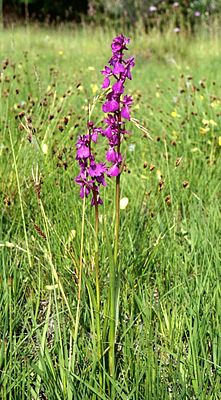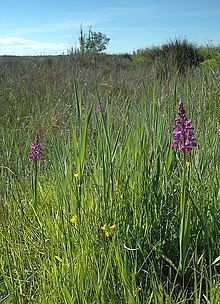Marsh orchid
| Marsh orchid | ||||||||||||
|---|---|---|---|---|---|---|---|---|---|---|---|---|

Marsh orchid ( Anacamptis palustris ) |
||||||||||||
| Systematics | ||||||||||||
|
||||||||||||
| Scientific name | ||||||||||||
| Anacamptis palustris | ||||||||||||
| (L.) Rich. |
The marsh orchid ( Anacamptis palustris ) is a plant from the genus of anacamptis ( Anacamptis ) within the family of orchid (Orchidaceae).
description
Appearance and leaf
The marsh orchid is a slender, graceful, perennial herbaceous plant and reaches heights of up to 60 centimeters. The narrow, lanceolate, narrowly folded leaves stand upright and are distributed on the green stem, which has turned purple in its upper part.
Inflorescence and flower
The loose inflorescence is cylindrical to elongated. The strong bracts support the laterally protruding, twisted ovary and are about as long as this. The relatively large, hermaphrodite flowers are radial symmetry and threefold. The bloom cladding sheets with the broad lip are from purple to dark pink to - very rarely - completely white. The horizontal to slightly upward pointing spur is about as long as the ovary. The lateral sepals are turned back, directed almost vertically upwards, the middle one with the petals forms a loose helmet over the column. The lip is rounded and lobed, the middle lobe in front is again divided into two diverging, rounded ends. The lightened center of the lip is dotted to dashed.
The flowering time extends from the end of May to the beginning of July, in the south of the distribution area from April to June.
The number of chromosomes is 2n = 42.
Occurrence and endangerment
The very patchy distribution area in Europe extends from Spain and Italy to France , western Switzerland , Germany to Slovenia , Austria, the Czech Republic and Hungary , and north to Gotland . Marsh orchid is very rare in all countries today, although it used to be widespread. It is assumed that this species is even more common in southern and eastern Europe. According to Baumann and Künkele , the species has the following altitude limits: Germany 10–550 meters, France 0–1800 meters, Switzerland 420–780 meters, Liechtenstein 450 meters, Austria 120–200 meters, Italy 1–500 meters, Slovenia 170–450 meters, Europe 0–1800 meters, Turkey up to 1950 meters above sea level.
In the 1996 Red List of Endangered Plant Species in Germany, it was rated as Category 2 = “highly endangered”. In Bavaria , Baden-Württemberg , Thuringia , Saxony-Anhalt , Brandenburg and Mecklenburg-Western Pomerania it is rated as "critically endangered" and in Berlin, Hesse, Lower Saxony, Rhineland-Palatinate, Saxony and Schleswig-Holstein it is considered "extinct" .
Since 1980, marsh orchid has only been registered in Bavaria, Baden-Württemberg, for example, in the Erlich nature reserve , and in Brandenburg, for example, in the Luchwiesen nature reserve , Thuringia and Saxony-Anhalt. In Thuringia there are currently three populations with few individuals north of Erfurt. In Bavaria there are still few populations in low moors in the Chiemgau and in the western Inn Valley.
The marsh orchid is a characteristic species of the Schoenetum nigricantis from the association Caricion davallianae in Central Europe, but also occurs in societies of the associations Calthion or Molinion.
The largest stocks that still exist in Germany, in the fens of the Bavarian foothills of the Alps, are acutely threatened with extinction due to intensification of agriculture, drainage, but also fallow traps and scrub . The marsh orchid disappears both when it is used more intensively and when it is consumed, i.e. when use or care ceases entirely; it is then overgrown by reeds . A one-time mowing late in the year is recommended for maintenance. In the Mediterranean area, the subspecies are almost exclusively distributed in dune valleys on the sea coasts (locations where the wind has blown the dune sand below the water table and which have become swampy as a result). In addition, there are few deposits inland , for example at saline springs in central Italy (for example the sulfur-containing springs of Bagnaccio in Tuscany). Probably the largest remaining populations, in Northern Italy , are also considered threatened. Anacamptis palustris is endangered in the Mediterranean area mainly due to the intensive use and construction activity in the coastal regions. The remaining stocks are genetically isolated from one another and show little genetic diversity .
For the three subspecies, the IUCN 2013 rated Anacamptis palustris in the entire distribution area as "Least Concern" = "not endangered". The stocks are falling. Anacamptis palustris occurs in at least 49 locations in the Mediterranean region, 8 of which are in North Africa. The area is very fragmented, especially the North African populations are very fragmented and reduced. The populations are declining due to habitat loss . Anacamptis palustris is very rare in Morocco and only occurs in one place in Chaouia. In Algeria it is rare with only three locations on the coast in the suburbs of Algiers (Fort de l'eau, Mitidja, Castiglione), where it has not been found since 1976. In Tunisia there are four known sites from the northeast (Menzel Djemil, El Alia and Foundouk Djedid) to Cap Bon (Mraïssa), but it has not been seen there for a century. It occurs in 26 Spanish regions on the central and eastern Iberian Peninsula. In France it is quite rare on the Mediterranean coast, but it is found in 11 regions as well as Corsica . It occurs in eight Italian provinces. In Turkey it occurs in 37 localities and in Cyprus in 6 localities.
In Central Europe, the swamp orchid thrives in never desiccating fens and wetlands, rare hillside moors, to change wet on wet, basic marsh humus soils . The plant is salt bearing .
Systematics
It was first published in 1787 under the name ( Basionym ) Orchis palustris Jacq. Since 1997 this species has been assigned to the formerly monotypical genus of the dog sausage ( Anacamptis ) established in 1817 , before it belonged to the genus of orchids (Orchis) in the narrower sense. During a revision of the orchid species of the subtribe Orchidinae on the basis of genetic traits, the marsh orchid was classified together with some other species in the genus Hundswurzen ( Anacamptis ) as Anacamptis palustris (L.) RMBateman, Pridgeon & MWChase . The old scientific name is still used in older literature.
The botanical genus name Anacamptis is derived from the Greek word ανακάμτειν anakamptein for to bend, because of the bent lateral bracts of the perigone or because of the bent anthers . The specific epithet palustris means "living in the swamp" and refers to the location.
Subspecies
From Anacamptis palustris there are about three subspecies:
- Anacamptis palustris subsp. elegans (Heuff.) RMBateman, Pridgeon & MWChase : It occurs from eastern Central Europe to Central Asia and Southwest Asia.
- Anacamptis palustris (Jacq.) RMBateman, Pridgeon & MWChase subsp. palustris : It occurs from Europe to northwest Africa.
- Robust orchid ( Anacamptis palustris subsp. Robusta (T.Stephenson) RMBateman, Pridgeon & MWChase ): It occurs from northern Algeria to Tunisia, on Mallorca , Crete and the Greek island of Kefalonia .
Hybrids
The marsh orchid ( Anacamptis palustris ) forms hybrids with closely related species such as the little orchid ( Anacamptis morio ) and the orchid orchid ( Orchis coriophora ).
literature
- Horst Kretzschmar, Wolfgang Eccarius, Helga Dietrich: The Orchid Genera Anacamptis, Orchis and Neotinea. Phylogeny, taxonomy, morphology, biology, distribution, ecology and hybridization. 2nd edition, pp. 1-544. EchinoMedia Verlag, Bürgel, 2007, ISBN 978-3-937107-12-7 .
- Dietmar Aichele, Heinz-Werner Schwegler: The flowering plants of Central Europe . 2nd Edition. tape 5 : Swan flowers to duckweed plants . Franckh-Kosmos, Stuttgart 2000, ISBN 3-440-08048-X .
Individual evidence
- ↑ a b Erich Oberdorfer : Plant-sociological excursion flora for Germany and neighboring areas . With the collaboration of Angelika Schwabe and Theo Müller. 8th, heavily revised and expanded edition. Eugen Ulmer, Stuttgart (Hohenheim) 2001, ISBN 3-8001-3131-5 , pp. 281 .
- ↑ Horst Kretzschmar: Anacamptis palustris at orchideen-kartierung.de .
- ↑ Helmut Baumann , Siegfried Künkele : Orchidaceae . In: Oskar Sebald u. a .: The fern and flowering plants of Baden-Württemberg . 1st edition Volume 8, page 397. Verlag Eugen Ulmer, Stuttgart 1998. ISBN 3-8001-3359-8
- ↑ Orchis palustris Jacq. sl, marsh orchid. In: FloraWeb.de.
- ↑ Michael Hassler, Bernd Schmitt: data sheet at Flora von Deutschland - a picture database , version 3.03.
- ↑ Appreciation of the "Erlich" nature reserve from March 27, 2003 , accessed on April 2, 2016
- ↑ Uli Christmann: Protected areas in Dahmeland - The Luchwiesen nature reserve
- ↑ Distribution map for Germany. In: Floraweb .
- ↑ Hans Nositschka: Perspectives of nature conservation and landscape management in the state of Thuringia. In: Karl-Hermann Hübler (editor): Nature conservation in the new federal states: Opportunities for landscape development, evaluation of nature conservation policy, status of legislation in the new federal states and in Berlin . Blottner Verlag, 1993. on page 80.
- ↑ Marsh orchid (Orchis palustris Jacq.). Specially protected plants in Thuringia, TLUG Jena 2006, distribution map according to the TK25 quadrant. ( Memento of the original from January 20, 2015 in the Internet Archive ) Info: The archive link was inserted automatically and has not yet been checked. Please check the original and archive link according to the instructions and then remove this notice. accessed on April 13, 2016
- ^ A b Franz Rottler: Sumpfknabenkraut, Die Orchideen in Bayern published by the AHO Arbeitskreis Heimische Orchideen Bayern eV, 2012.
- ↑ Sara Magrini, Alessandro De Carli, Silvano Onofri, Anna Scoppola: A comparative study of the seed germination capabilities of Anacamptis palustris (Orchidaceae), a threatened terrestrial orchid, and other more common Anacamptis species, by asymbiotic culture in vitro. In: European Journal of Environmental Sciences , Volume 1, Issue 2 :, 2011, pp. 71-79. Full text source
- ↑ Anacamptis palustris in the IUCN Red List of Threatened Species 2015-4. Posted by: S. Kavak, 2013. Retrieved April 8, 2016.
- ↑ RM Bateman, AM Pridgeon, MW Chase: Phylogenetics of subtribe Orchidinae (Orchidoideae, Orchidaceae) based on nuclear ITS sequences. 2. Infrageneric relationships and reclassification to achieve monophyly of Orchis sensu stricto. In: Lindleyana. The scientific journal of the American Orchid Society. West Palm Beach Fla 12, 1997, pp. 113-141. ISSN 0889-258X
- ↑ a b c d Rafaël Govaerts (Ed.): Anacamptis palustris. In: World Checklist of Selected Plant Families (WCSP) - The Board of Trustees of the Royal Botanic Gardens, Kew . Retrieved November 26, 2016.
- ^ Helmut Baumann , Siegfried Künkele and Richard Lorenz: Orchids in Europe with adjacent areas . Verlag Eugen Ulmer, Stuttgart, 2006. ISBN 978-3-8001-4162-3 . Page 236.
Web links
![]() Marsh orchid ( Anacamptis palustris )
Marsh orchid ( Anacamptis palustris )
- Orchis palustris subsp. elegans (Heuff.) Nyár., High Marsh Orchid. In: FloraWeb.de.
- Orchis palustris subsp. palustris Jacq., marsh orchid (subspecies). In: FloraWeb.de.
- Marsh orchid at natur-lexikon.com
- Franz Rotter, 2012: Orchis palustris at AHO-Bayern
- Marsh orchid . In: BiolFlor, the database of biological-ecological characteristics of the flora of Germany.
- Profile and distribution map for Bavaria . In: Botanical Information Hub of Bavaria .
- Marsh orchid In: Info Flora , the national data and information center for Swiss flora .
- Distribution in the northern hemisphere according to: Eric Hultén , Magnus Fries: Atlas of North European vascular plants 1986, ISBN 3-87429-263-0 .
- Distribution map for Switzerland (AGEO).
- Thomas Meyer: Data sheet with identification key and photos at Flora-de: Flora von Deutschland (old name of the website: Flowers in Swabia )
- The orchids of the Rhön : Marsh orchid ( Anacamptis palustris )
- AGEO (Switzerland): Anacamptis palustris .
- Collection of images at flora-don.sfedu.ru .
- Data sheet at WISIA .
- Michael Hassler, Bernd Schmitt: Data sheet of Anacamptis palustris subsp. palustris at Flora von Germany - A picture database , version 3.03.



